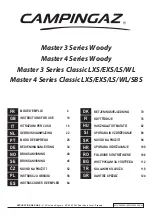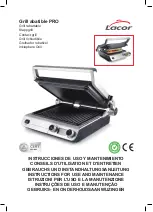
GB
very aggressive to stainless steel.
y
Never use oven cleaners that contain caustic chemicals.
y
Do not use paper towel or scratch-sponges.
To keep your barbecue looking new, we recommend you
cover it with a Campingaz
®
protective cover available as an
accessory.
Important:
Wait for the barbecue to cool down completely before putting
on its protective cover. At the beginning of the season, apply a
coat of linseed oil or teak oil onto the wood parts with a rag or
brush in order to give them a more brilliant appearance and to
maintain their protection.
Q. STORAGE
y
Close the gas cylinder valve after use.
y
If you store your barbecue indoors, disconnect the gas
cylinder and store the cylinder outdoors.
y
If you store your barbecue outdoors, it is recommended that
a protective cover be used.
y
When not used for a long period of time, it is recommended
that the barbecue be stored in a dry, sheltered place (e.g.:
garage).
y
(Featured on certain models only) Side tables could be
lowered and folded inward (read Assembly Manual included
in the package).
R. ACCESSORIES
Depending on the model, your barbecue may be equipped with
a
Campingaz
®
Culinary Modular
grid.
The
Campingaz
®
Culinary Modular
cooking grid is made up
of 2 parts:
• the contour
• the centre
(Fig. 13) The centre is removable and may be replaced by
one of the accessories sold separately by Campingaz
®
, for
example:
• Pizza stone
• Wok
• Paella plate
The
Campingaz
®
Culinary Modular
concept therefore allows
you to transform your barbecue into a true outdoor kitchen
and to use a specific cooking support depending on what you
are preparing.
If your model of barbecue is not equipped with a
Campingaz
®
Culinary Modular
grid, you may purchase one separately.
ADG advises that its gas barbecues should systematically
be used with accessories and replacement parts from
Campingaz
®
. ADG accepts no responsibility for any
damage or malfunction due to the use of accessories and/
or replacement parts from other brands.
S. PROTECTING THE ENVIRONMENT
Think about protecting the environment! Your equipment
contains materials which can be recovered or recycled. Hand
them in to the waste collection service in your municipality and
sort the packing materials.
T. BATTERY RECOMMENDATIONS
This symbol found on the batteries means that at the
end of their lives, the batteries must be removed from
the unit, and then recycled or properly disposed of.
The batteries should not be thrown into the trash, but
should be brought to a collection point (dump...). Check with
your local authorities. Never dispose of in nature, do not
incinerate: the presence of certain substances (Hg, Pb, Cd, Zn,
Ni) in used batteries may be hazardous to the environment and
human health.
U. ELECTRICAL AND ELECTRONIC WASTE
This symbol means that the appliance’s electrical
system must be disposed of selectively. At the end of
its life, the appliance’s electrical system must be
scrapped correctly. The electrical system must not be
disposed of with unsorted household wastes.
Selective collection of waste promotes reuse, recycling or other
forms of recovery of recyclable materials contained in this
waste. Take the appliance’s electrical system to a waste
recovery centre designed for the purpose (waste collection
point). Check with your local authorities. Never dispose of in
nature, do not incinerate: the presence of certain hazardous
substances in electrical and electronic equipment can be
harmful to the environment, and have a potential effect on
human health.
13














































